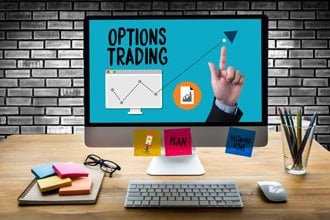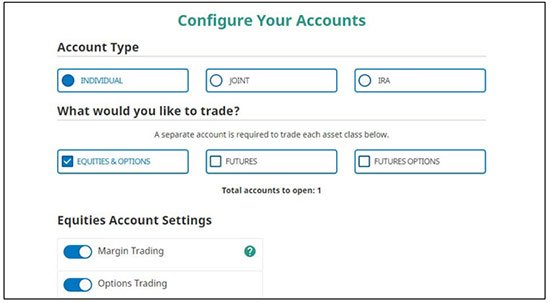You've heard what options can do for you, and you're eager to start trading. The good news is it's now easier than ever to get a brokerage account that lets you trade options.
Getting a Broker
 A broker is the platform on which you trade options. To set up an account, just follow these three easy steps:
A broker is the platform on which you trade options. To set up an account, just follow these three easy steps:
Step 1. Select your broker: You could look brokers up online, or simply use the list provided below.
Step 2. Set up your account: You can do this over the phone using the number below or the contact info found on the broker's site, or just do it all online.
Step 3. Fund your account: With a bank account and routing number, you can transfer money directly into your trading account.
To help you with broker selections, we've identified firms with the lowest account minimums and commission fees that don't compromise on quality customer service. Listed below are some top discount brokers.
TradeStation has top-notch customer service and an easy website to navigate. The seamless experience is especially useful for beginning options investors.
| Broker | Contact | Types of Trades | Minimums to Open | Pricing |
| Robinhood | robinhood.com Online Only |
Stocks, ETFs, options, cryptocurrencies | None | None |
| TradeStation | tradestation.com 1.800.328.1982 | Stocks, ETFs, options, futures, mutual funds, bonds | $500.00 | Stocks & ETFs: $5 Options: $5 + $0.50 per contract |
| Charles Schwab | schwab.com 1.800.435.4000 | Mutual funds, ETFs, CDs/money market, domestic and international stocks, bonds, options, futures | $1,000.00 | Stocks & ETFs: $0 for online trades Options: $0.65 per contract for online trades |
| Fidelity | fidelity.com 1.800.343.3548 | Mutual funds, IRAs, stocks, bonds, ETFs, and options | $0, or $4.95 for options | All online U.S. equity trades: $0 Options: $0.65 per contract |
| TD Ameritrade |
tdameritrade.com 1.800.454.9272 | Stocks, options, mutual funds, and futures | $0, or $2,000.00 for Margin or option privileges |
Stocks and ETFs: $0 Options: $0.65/contract |
Disclaimer: Neither Money Morning nor Money Map Press is a broker, dealer, or licensed investment advisor. The author should not be considered as permitted to engage in rendering personalized investment, legal, or other professional advice as an agent of Money Map Press. Money Map Press does not receive any compensation for these services. Additionally, any individual services rendered to Money Map Press by the companies listed are considered completely separate from and outside the scope of services offered by Money Map Press. Any contact and resulting relationship is strictly between you and the company.
Discount vs. Full-Service Brokers
The brokers we've chosen here are called "discount brokers" because they are less expensive than the full-service firms.
Full-service brokers can sometimes charge hundreds of dollars for their services. They can also charge you an annual percentage of your portfolio - so the more you make, the more you pay.
You should use whichever brokerage platform is right for you. The discount brokers listed above might meet your investment needs for a fraction of the full-service cost. If you prefer full service, go that route.
Setting Up Your Account
Most brokers allow you to set up an account over the phone or on their webpage, whichever you're more comfortable with.
You'll be asked to provide personal information - typically your contact information, employment status, annual income, and approximate net worth.
You'll also be asked to select between several account types, as well as what you'd like to trade. You might see a screen like this:

Source: TradeStation.com
While we can't advise you on what account to open, individual cash accounts are the most common. Once your account is open and funded, you will immediately have the ability to buy and sell stocks.
Options Clearance
Before you can begin to trade options, you need to make sure you have the right account and the highest level of options trading clearance possible.
You will need to answer a few questions so that your broker can be sure you are well prepared to buy and sell options contracts. All of the questions you answer will help determine what level of options trading you'll get clearance for.
Don't worry. These are not trick questions, and I'll walk you through what to expect.
The goal is to get the highest level of options trading clearance possible. You may not want to do some of the more advanced techniques right away, but it helps to have the clearance to do so when you're ready.
Personal Finances: These will be basic questions about yourself: your employment, yearly income, net worth, or your liquid net worth. While it may be tempting to fudge these answers a little bit to make your portfolio seem larger, don't. This is all easy to verify.
Investment Objectives: Here you will be prompted to clarify your larger goal for investing - whether you are on the conservative side and aiming for income, or on the aggressive side and more speculative. If you want to qualify for something more than covered calls - which you'll likely want to do at some point - then select the speculative option.
Options Strategies: Not all brokers will request that you select options strategies - certain strategies may already be included in whatever clearance level you are approved for. But some ask you to select particular strategies rather than select an inclusive clearance level. These strategies start simple - with buying options contracts - then get more sophisticated, which includes buying credit and debit spreads, writing naked calls and puts, strangles, and straddles. In general, the more strategies you select, the higher your trading clearance will be.
Trading Experience: You will likely be asked about your experience trading stocks and options. If you don't have much experience, it's OK. This is more of a formality. If you select a moderate degree of experience, this will likely help you get a higher clearance level.
The levels of trading and the terms used to describe different kinds of options can vary between brokerages.
For example, TD Ameritrade features four levels of options clearance:
Tier 1, Covered: Write covered calls, write cash-secured puts
Tier 2, Standard Cash: Purchase options + Tier 1/Covered
Tier 2, Standard Margin: Create spreads, write covered puts, + Tier 2/Standard Cash
Tier 3, Advanced: Write uncovered options + Tier 2/Standard Margin
Once you've answered these questions, you'll have your options clearance and are ready to make your first trade.
Now, if you really want to kick your options trading game into high gear...
You Can Collect Four Separate Paydays in Under a Minute with This Options Trading Secret
Live on camera, America's No. 1 Pattern Trader is showing you the secret behind some of his biggest trades to date.
Watch as he uses this special tool to collect four separate paydays in under a minute - all from enormous companies like Netflix, Apple, Facebook, even Amazon.
While it may have taken Tom years to invent this moneymaking "machine," it's super easy to understand and utilize.
All it takes is a few simple mouse clicks, and you could be hundreds, even thousands, richer.
This is an opportunity you won't want to miss out on.


